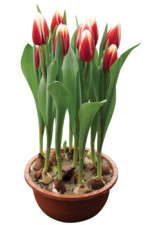Potted Tulip Guidelines For The Greenhouse

Who would connect tulips with stories from the Orient? The prevalent perception is that tulips are native to Holland. Yet, before they were introduced to Holland, they had been cultivated in the Orient for ages.
At the court of the Turkish sultan, tulips were grown in the palace gardens. Early tulips were cultivated from wild flowers native to the steppes of Central Asia. During the 1500s, tulips found their way to Holland. Initially, tulips were a status symbol of immense prestige. Then they became the center of financial ruin–tulipomania–in the economic collapse of 1637. Today, they are a national icon and the foremost-recognized product of The Netherlands.
Hybridizing efforts over the centuries created an extensive assortment of high-performing cultivars. They are a living legacy, a tradition ancient and new, a product of ingenuity and commerce. At Longwood Gardens, the tulip displays are a tradition since 1921. Hundreds of thousands of spring bulbs are shown during the winter and spring displays. The pot tulip program displayed from November through April in the conservatories grew over time to become a great attraction. Seeing tulips in flower during the dead of winter in the conservatory or acres of tulips in the spring in the outdoor garden is a sight to behold.
Potted Tulip Production
For forcing tulips in pots, you should work with top-size bulbs. Top size is grade 12+ (bulbs with a circumference of 12 centimeters or more) for most tulip divisions suitable for forcing. Some of the smaller plants, such as species tulips, generally are available in grade 6+.
I work with standard forcing grade bulbs–bulbs not “prepared” or “pre-cooled.” Over the years, I have worked with numerous cultivars from different tulip divisions like Triumph, Single Early, Double Early, Single Late and Fringed tulips. I also force species tulips like Tulipa bakeri ‘Lilac Wonder’ and Tulipa linifolia.
I have learned a lot from my suppliers, and I encourage you to find a good sales representative as well. The supplier should provide you information, such as optimal vernalization requirements, general culture guidelines and help with troubleshooting if something is not working as it should.
Sales representatives can be very helpful in cultivar selection for your market segment. Finding a reliable rep is not always easy, though. I have spent several years working with a number of suppliers before finding companies I am comfortable with. I keep records of bulb quality, reliability and customer service. I make purchasing decisions based on this information.
Because our forcing program consists of more than 60 cultivars each season, I generally work with four to five companies to fill the order. No single company carries all the cultivars needed for our display.
Each January, I compile the upcoming season’s list and mail it to the suppliers. I request prices for those cultivars offered by the supplier and the final quote is to include the transportation cost. Lock in a final price that includes delivery to your doorstep, otherwise you might get unforeseen charges such as energy surcharge and customs surcharge. It is quite remarkable what some companies will add to the bill. With this process, I aim for the best quality bulbs for a fair price. I have learned to understand the saying: “You get what you pay for.”
By contracting early and working with the right suppliers, I get excellent bulbs, good customer service and the advice and help I need. All this is available with proper planning for a reasonable price.
Meeting Holiday Demand
It is most gratifying to see the reactions of our guests when seeing red and white tulips on display. Using tulips in combination with season staples, such as poinsettias and paper-whites, provides for an unexpected “wow” factor. Growing potted tulips for our Christmas display, however, has been challenging because Dutch-grown bulbs did not work out for the November display dates. The earliest delivery date for Dutch-grown tulip bulbs is September. This does not allow enough time for growing a high-quality crop.
A few years ago, we solved this problem by purchasing bulbs from suppliers in Tasmania, New Zealand and Chile. Planting dates are in July and I am able to finish high-quality tulip crops for the Christmas season’s show opening on Thanksgiving Day. Considering how popular our Christmas tulips have become, I wonder about the potential consumer demand for this product line in November and December. Is the room for alternative product lines in the holiday assortment?
Media & Potting
To pot tulips, we use an in-house mix that we also use for potting other bulb crops. Our bulb mix consists of the following components: 50 percent peat moss, 35 percent coarse sand and 15 percent vermiculite. To the media, I add 1.5 pounds of RootShield and pulverized Dolomite lime to adjust the pH to a range of 6 to 6.5. Several commercially available potting mixes, like Metromix 350 and Sunshine Mix 4, have been suggested for growing potted tulips.
Upon arrival, check the bulbs and document any problems right away. Do not plant damaged or diseased bulbs. Watch out for white mold and rot on the bulbs. This could be a sign of a Fusarium infestation of the bulbs. Powdery residue on bulbs could be a sign of bulb mites. These bulbs should find their way into a trash can and not into your cooler. Inform your rep and get a replacement. It is always good to take pictures of the infested bulbs before filing a claim.
I plant tulips into bulb pans and only some of the small species tulips are planted into standard pots. Vigorous and tall cultivars go into 8-inch pans. Most pot cultivars perform well in 6-inch bulb pans, whereas the botanical tulips show best in 4-inch standard pots.
Containers are filled with potting media so the tip of the bulb is just sticking out of the media. When working with a peat light mix, plant a bit deeper–especially in the light mixes bulbs may pop out of the soil when growing. I place seven bulbs per pot, making sure the flat side of the bulb is facing the wall of the pot. Proper arrangement of the bulbs is essential, as the results are well-balanced pots of self-supporting plants. Orienting the flat side to the wall of the pot ensures the first large leaf of the plant will unfold to the outside of the pot. This prevents overcrowding the center of the pot with foliage.
Vernalization & Forcing
Vernalization is essentially an artificial winter, a defined period in which bulbs are cooled. This process is important–without it, tulips may not flower. This process occurs in a dark and a temperature-controlled environment. Vernalization treatment for tulips is divided into three stages:
Stage 1. The well-watered pots are placed into a cooler with a temperature set point of 48°F. At this temperature bulbs will start growing roots. Because I am growing so many different cultivars I frequently have to check pots. The rate of root growth depends on the cultivars and can vary greatly. I monitor the development of the root system at least once a week. Once I see roots growing out of the drainage holes at the bottom of the pots, I move them to Stage 2. Stage 1 requires an average of three weeks.
Stage 2. Pots are placed into a cooler with a temperature set point of 41°F. During this stage bulbs start growing small shoots. The shoots should show slightly above the media but should not reach more than 1 inch in height. This stage will take several weeks depending on the cultivar. I check my coolers at least weekly to catch each crop at the right developmental stage. At that time, pots are moved to Stage 3 for the finishing stage.
Stage 3. The temperature set point of the cooler is 34°F. Pots are held at this temperature until the required optimal chilling requirement is met. This requirement varies among the different cultivars. The total amount of time of all cooler stages (S) should be equal to the optimal vernalization requirement (OVR). The vernalization requirement is generally expressed in weeks.
This process can be described by the following function: OVR = S1 + S2 + S3.
The time required for vernalization varies between cultivars. In general, vernalization ranges from 14 to 16 weeks. The greenhouse bench time or forcing time also ranges from 15 to 30 days for different cultivars.
Forcing
Forcing is a technique to initiate flower outside the normal timeframe. For tulips, temperature is used to bring plants into flower. I run my greenhouse at a temperature range of 55 to 65°F. Tulips grown at lower temperatures usually are of higher quality. The crops, however, take longer to finish and low-temperature forcing may not be feasible for commercial growers.
For Longwood Gardens’ December and January crops, I run the greenhouse warmer to finish crops on time. I have had good results using a temperature range of 62 to 68°F for the early-season crops or when crops are needed ahead of schedule. Temperatures over 68°F should be avoided, otherwise the tulip topple disorder may develop. Potted tulips prefer moderately high light levels of about 2,000 to 2,500 footcandles. But intense sun can cause scalding of the foliage and the flowers.
Fertilizer
I use a calcium nitrate liquid fertilizer with a concentration of 350 ppm every 10 days. This fertilizer application is especially important when pushing tulips at higher temperatures to prevent the stem topple disorder. Additional fertilization of the crop is not necessary.








